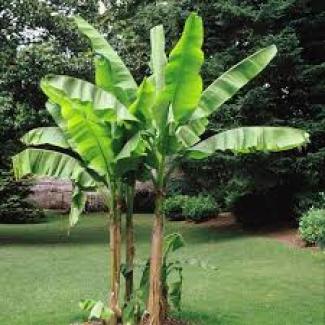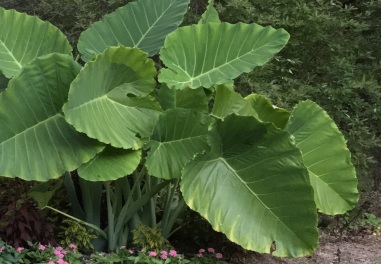Overwintering Elephant Ears and Banana Trees
Elephant Ear Plants and Banana Trees with their large leaves add a tropical or coastal feel to our landscape. Grown in ground or in containers these perennials can be enjoyed year after year in our yards.
Their foliage is affected by freezing temps and heavy frost turning their leaves dark brown to black almost overnight, but the underground tuber is not affected on many species – so they are still very much alive!

Only the foliage has died back, the tubers (bulb and root ball underground) are still kickin’. In our climate, the tubers are winter hardy, so removing them from the garden in fall or early winter and replanting them in the spring is not necessary.

Over the past 30 years our area has experienced 2 periods of prolonged excessive cold (consistent low temps in the 20s and teens) that caused serious damage to most Elephant Ears and Banana Trees, resulting in some to not come back. No one can control or guess what Mother Nature will do, but under normal conditions these plants overwinter well.
Overwintering Elephant Ears Tips
-
You can prepare them for winter prior to inclement weather when it is more pleasant to work outdoors, or you can wait and cut them back after the foliage turns black.
-
Some gardeners believe it is best to let the stems die back naturally versus cutting them which could lead to rot. I’ve done this both ways and have not noticed a difference.
-
When cutting the stems off be careful of the milky sap, it can be a skin irritant. My husband discovered this the hard way, he had itchy skin for several days where the sap came in to contact with his skin, whereas it didn’t have that effect on me.
-
After cutting or allowing them to die back cover the plant with a small mound of mulch, leaves, grass cuttings – something to help protect it from the cold.
-
When spring arrives, remove some of the protective layer so the sun can help heat the soil. Once our soil is 60 to 65 degrees you should see new growth emerging.
Overwintering Banana Tree Tips
-
-
Just like the Elephant Ears you can prepare them for winter prior to the arrival of inclement weather or wait until the foliage turns black.
-
Again, like the Elephant Ears, be careful of the milky sap, it can be a skin irritant.
-
You can cut each leaf frond from the trunk and then remove the trunk itself or cut the whole tree down fronds intact. (I suggest removing the fronds first if it is a large tree, they can be quite heavy and bulky to move otherwise.)
-
Cut the trunk down close to the ground and cover the plant with a small mound of much, leaves or grass cuttings to help protect it from the cold.
-
When spring arrives, remove some of the protective layer so the sun can help heat the soil. You will see a new plant emerge from the edge of the tuber once the ground temperature has warmed up to 60 – 65 degrees.
-


